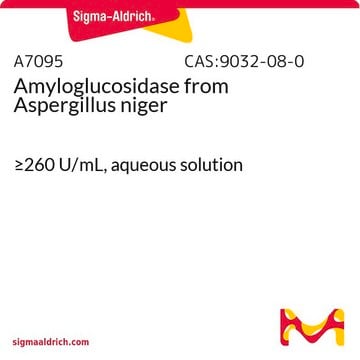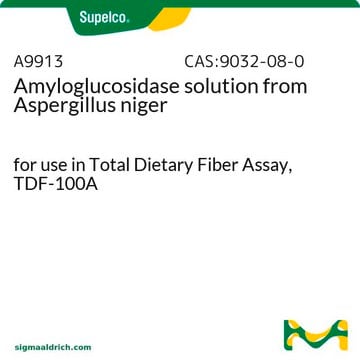A3403
α-Amylase from Bacillus licheniformis
Type XII-A, saline solution, ≥500 units/mg protein (biuret)
Synonym(s):
Termamyl® 2X, 1,4-α-D-Glucan-glucanohydrolase
Sign Into View Organizational & Contract Pricing
All Photos(2)
About This Item
CAS Number:
MDL number:
UNSPSC Code:
12352204
eCl@ss:
32160410
NACRES:
NA.54
Recommended Products
type
Type XII-A
Quality Level
form
saline solution
specific activity
≥500 units/mg protein (biuret)
mol wt
57.6 kDa
greener alternative product characteristics
Waste Prevention
Design for Energy Efficiency
Learn more about the Principles of Green Chemistry.
sustainability
Greener Alternative Product
greener alternative category
storage temp.
2-8°C
Looking for similar products? Visit Product Comparison Guide
General description
α-Amylase is a member of the endo-amylase family. Its molecular weight is 57.6 kDa. α-Amylase is composed of three functional domains namely A, B and C. Domain A is a barrel-shaped (β/α)8 structure and is the largest domain. Domain B is linked to domain A via disulfide bond and is present between domain A and C. Domain C is composed of β-sheets and is connected to domain A via a polypeptide chain.
We are committed to bringing you Greener Alternative Products, which adhere to one or more of The 12 Principles of Greener Chemistry. This product has been enhanced for energy efficiency and waste prevention when used in starch ethanol research. For more information see the article in biofiles.
We are committed to bringing you Greener Alternative Products, which adhere to one or more of The 12 Principles of Greener Chemistry. This product has been enhanced for energy efficiency and waste prevention when used in starch ethanol research. For more information see the article in biofiles.
Application
α-Amylase is used to hydrolyze α bonds of α-linked polysaccharides, such as starch and glycogen. Product A3403 is from Bacillus licheniformis and is type XII-A. α-Amylase, from Sigma, has been used in various plant studies, such as metabolism studies in Arabidopsis .
Biochem/physiol Actions
α-Amylase hydrolyzes the α-(1,4) glucan linkages in polysaccharides of three or more α-(1,4) linked D-glucose units. Natural substrates such as starch and glycogen are broken down into glucose and maltose.
Caution
Reported to be heat stable at temperatures as high as ∼90 °C.
Unit Definition
One unit will liberate 1.0 mg of maltose from starch in 3 min at pH 6.9 at 20 °C.
Physical form
Aqueous solution containing sodium chloride and sucrose
Legal Information
A product of Novozyme Corp.
Termamyl is a registered trademark of Novozymes Corp.
substrate
Signal Word
Danger
Hazard Statements
Precautionary Statements
Hazard Classifications
Resp. Sens. 1
Storage Class Code
10 - Combustible liquids
WGK
WGK 2
Flash Point(F)
Not applicable
Flash Point(C)
Not applicable
Personal Protective Equipment
dust mask type N95 (US), Eyeshields, Gloves
Choose from one of the most recent versions:
Already Own This Product?
Find documentation for the products that you have recently purchased in the Document Library.
Customers Also Viewed
Hisaaki Hiraoka et al.
Animal science journal = Nihon chikusan Gakkaiho, 83(10), 690-695 (2012-10-06)
To improve the performance of the analytical method for neutral detergent fiber in feed with heat-stable α-amylase treatment (aNDFom), the process of adding heat-stable α-amylase, as well as other analytical conditions, were examined. In this new process, the starch in
Xinyi Huang et al.
Tree physiology, 40(5), 652-666 (2020-02-23)
Globally, soil salinization is becoming increasingly prevalent, due to local hydrogeologic phenomena, climate change and anthropogenic activities. This has significantly curtailed current world food production and limits future production potential. In the prairie region of North America, sulfate salts, rather
C Fermaniuk et al.
Annals of botany, 128(7), 943-957 (2021-07-23)
Carbon reserves are a critical source of energy and substrates that allow trees to cope with periods of minimal carbon gain and/or high carbon demands, conditions which are prevalent in high-latitude forests. However, we have a poor understanding of carbon
Laura Escrivá et al.
Toxins, 14(1) (2022-01-21)
The presence of mycotoxins in cereals and cereal products remains a significant issue. The use of natural ingredients such as pumpkin and whey, which contain bioactive compounds, could be a strategy to reduce the use of conventional chemical preservatives. The
Seokmin Yoon et al.
Journal of microbiology and biotechnology, 32(1), 72-80 (2021-11-10)
In this study, the survival capacity (acid and bile salt tolerance, and adhesion to gut epithelial cells) and probiotic properties (enzyme activity-inhibition and anti-inflammatory activities, inhibition of adipogenesis, and stress hormone level reduction) of Lactiplantibacillus plantarum LRCC5314, isolated from kimchi
Our team of scientists has experience in all areas of research including Life Science, Material Science, Chemical Synthesis, Chromatography, Analytical and many others.
Contact Technical Service













